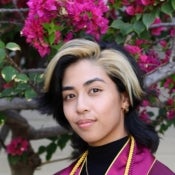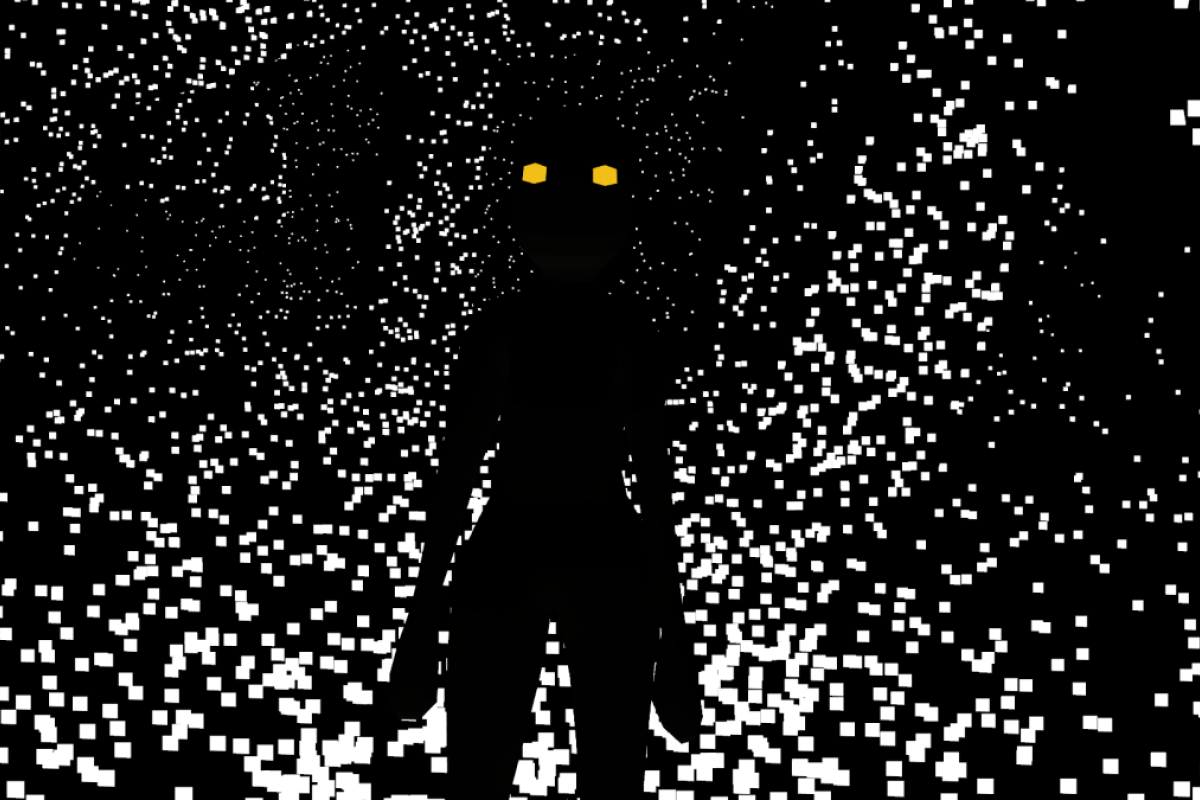Fueled by creativity: Graduate student completes six-year ASU journey without pause
Editor’s note: This story is part of a series of profiles of notable spring 2025 graduates.
From the moment she began her undergraduate studies, Olivia Reyes was determined to immerse herself in the intersection of art and technology.
In just six years — without taking a break between her bachelor's degree and master’s degree — she completed both at Arizona State University’s School of Arts, Media and Engineering, driven by her passion for immersive media and inspired by the example set by her mother.
“My mom has always emphasized the value of education — not just for career opportunities but for the connections you make and the communities you build,” said Reyes, who is completing her Master of Science in media arts and sciences with a concentration in extended reality technologies.
Watching her mother return to school after more than 20 years to earn a master’s degree in special education showed Reyes firsthand the power of perseverance.
“I wanted to follow in her footsteps,” she said. “Why wouldn’t I want to be like the person who inspires me the most?”
At ASU, Reyes explored the creative possibilities of extended reality (XR), game development and interactive storytelling. Through projects like her virtual reality (VR) capstone project, “Hear Me” — which challenged players to navigate a pitch-black world using their voice as a source of light — she honed her skills in game development and interaction design.
“We wanted to create a metaphor for overcoming anxiety and uncertainty through self-expression,” she said. “I’m proud of the mechanics we developed to explore themes of companionship and confidence.”
Alongside a VR training simulation for Komatsu, these projects showed her how digital experiences can go beyond entertainment to serve practical and educational purposes.
Her graduate studies allowed her to expand her expertise further, culminating in large-scale projection mapping installations and virtual production filmmaking. One of her proudest achievements was co-directing “Where Do the Cars Go?,” a short film entirely in a virtual production environment using the LED volume at the ASU Media and Immersive eXperience (MIX) Center.
“I never thought I’d be using game engines like Unreal to make a film,” she said. “The process of world-building for a film set versus a game was both familiar and completely new. It was a challenge, but an incredibly rewarding one.”
Another standout project was a projection-mapped experience that transformed a 3D LiDARLiDAR (Light Detection and Ranging) is a remote sensing method that uses laser light to measure distances and generate highly detailed 3D representations of physical environments. In the context of Reyes’ work, it was used to scan and model interior spaces, which were then transformed into immersive, stylized virtual environments for projection mapping and extended reality experiences. scan of the MIX Center into an immersive art installation.
“We wanted to explore the theme of abandoned spaces but ran into roadblocks getting access to real locations,” Reyes said. “So, we pivoted. We scanned the entire MIX Center and turned it into a stylized point cloud, animating textures and details to make it look like a forgotten space. Seeing people walk into that room and experience it in a new way was incredible.”
Now, as she prepares to graduate, Reyes looks forward to applying her skills in the professional world.
“The projects I worked on at ASU gave me real industry experience,” she said. “They weren’t just class assignments — they were opportunities to build a portfolio that I can confidently showcase to employers.”
Whether through game design, XR experiences or interactive storytelling, she hopes to create work that is not only visually engaging but also meaningful and impactful.
“There’s always more to explore, more to create,” she said. “That’s what keeps me going.”
Question: What was your “aha” moment when you realized you wanted to study the field you majored in?
Answer: My "aha" moment came when I was first considering college. Initially, I wanted to be an English major so I could teach English in other countries. But then I realized I could pursue that goal with any bachelor's degree, so I started thinking about what I was truly passionate about.
I've always been artistic — I’ve done art my whole life and studied graphic design throughout high school. A friend of mine who was already at ASU introduced me to the School of Arts, Media and Engineering and told me about the blend of art, technology and animation. That conversation immediately clicked with me. I’d always been interested in computer science but didn’t want to fully commit to a traditional computer science degree. AME (arts, media and engineering) felt like the perfect crossover.
Once I started my undergraduate studies, I discovered game development, extended reality and virtual reality through Robert LiKamWa’s class. That sparked a deep interest in me. I’ve loved video games my whole life, and this gave me the opportunity to explore that passion in a meaningful way. After earning my bachelor's degree, I knew I wanted to continue, so I pursued the new extended reality technologies (XRT) program. It was the perfect fit for my goals.
Question: What’s something you learned at ASU — in the classroom or otherwise — that surprised you or changed your perspective?
A: When I first got to ASU, I expected a strict, rigid academic environment where professors had a tight grip on what we could and couldn’t do creatively. But I was surprised — and relieved — to find the opposite. My professors were incredibly supportive, encouraging us to explore our own creative expression and incorporate ideas that mattered to us.
That level of freedom helped me grow not only as a student but as an artist and designer. I had the opportunity to explore cultural topics that were important to me and present them in meaningful ways. Having the space, technology and support to bring my ideas to life made all the difference. Now, as a graduate student, I have the confidence to execute my applied project in a way I never could have imagined when I first started.
Q: Why did you choose ASU?
A: I’ve lived in Arizona my whole life, and Phoenix is incredibly important to me. While I did consider studying in other states, ASU always felt like the right choice.
The AME program was a huge factor in my decision. It’s a relatively unique program that you can’t find at just any university. The technology, tools and creative spaces — especially at the MIX Center — are incredible and inspiring. Every time I walk in, I feel lucky to have access to such cutting-edge facilities. It puts me a step ahead in my career and fuels my creativity in ways I never expected.
Q: Which professor taught you the most important lesson while at ASU?
A: I’ve learned so much from so many professors, but one moment that stands out was during my graduate program with Professor Sven Ortel.
A couple of semesters ago, we were working on a large-scale projection mapping project in the Enhanced Immersion Studio. As students, we kept asking, 'What’s possible? What are we allowed to do?' Sven was firm in his response: 'You decide what you want to express, and we’ll figure out how to make it happen.'
That mindset shift was huge for me. Instead of limiting my ideas based on perceived constraints, I learned to dream big first and figure out logistics later. It changed the way I approach projects, and that lesson will stay with me throughout my career.
Q: What’s the best piece of advice you’d give to those still in school?
A: Take risks. More importantly, don’t be the first person to say "no" to your own ideas.
It sounds cliché, but so many students hold themselves back because they assume they won’t have the resources, support or skills to bring their ideas to life. But you never know until you try. If you believe in an idea, pursue it. You’ll be surprised at how many people — whether they’re fellow students, professors or staff — will support you along the way.
Believe in your ideas, take that risk and share your work with the world.
Q: What was your favorite spot on campus, whether for studying, meeting friends, or just thinking about life?
A: During my undergrad, my favorite spot was the Fab Lab in Stauffer B. It was such a lively space, full of creative energy. Being around other students who were just as passionate about their projects made it the perfect place to work. If I ever needed feedback, I could turn to anyone in the lab and get an honest, valuable critique. It felt like a little home within ASU.
Now, as a grad student, I’d say it’s a tie between the Fab Lab at the MIX Center and a small lounge area on the third floor near the staff offices. It has a big table, comfy chairs and even a Nintendo Switch that students can use. It’s a great atmosphere — some people are gaming, others are studying and friends are gathered talking.
Q: What are your plans after graduation?
A: The big question! My goal is to find a career that allows me to combine game design, immersive media and art in a way that makes a real impact.
ASU taught me that art can be more than just "cool" — it can engage communities, inspire people and create meaningful experiences. That’s what I want to continue doing. Whether it’s in game design, XR or another creative field, I want my work to connect with people in a deeper way.
Ideally, I’d love to stay in the Valley. Arizona may not be the biggest hub for immersive media or film, but there are so many local art collectives, galleries and organizations that need artists. I hope to use my skills in design and community engagement to contribute to those efforts and give back to the city that shaped me.
Q: If someone gave you $40 million to solve one problem on our planet, what would you tackle?
A: Education, hands down.
My mom is a special education teacher in Phoenix, so I’ve seen firsthand the challenges that teachers face — especially in Arizona, where education funding and teacher pay are among the lowest in the country.
I would use the money to fund schools, improve after-school programs and provide better resources for Title I schools that struggle with basic supplies. I’d also fight for better pay for public school teachers, who do so much for their students without nearly enough support.
Teachers deserve more, and investing in education is investing in the future.
More Sun Devil community

Essential reading: Books with lessons to live by
“Books are the training weights of the mind.” — Epictetus, Greek Stoic philosopherThis is the 14th edition of the annual Essential Reading feature, which offers book recommendations by faculty and…

ASU Online grads honored at campus celebration
Rodney Perkins dreamed of becoming a doctor since high school, but after earning his undergraduate degree, he felt his college experience hadn’t fully prepared him for the next steps.This week, the…
Public service grads celebrate at Watts College Convocation
Nearly 1,000 new graduates celebrated their first full day as Arizona State University alumni on May 13 as the Watts College of Public Service and Community Solutions honored them at its…



